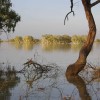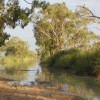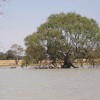
Description
Lake Cowal and Wilbertroy Wetlands
Located within a large fluvial floodplain, the Jemalong Plain, south side of the Lachlan River between Forbes and Condobolin, Lake Cowal/Wibertroy Wetlands are included on the Directory of Important Wetlands, and the National Trust has listed Lake Cowal as a ‘Landscape Conservations Area’. The lake system, which includes Lake Cowal, Nerang Cowal and Bogandillon Swamp covers around 25 500 ha, and it is the largest natural lake in the Lachlan Valley. Lake Cowal/Wibertroy Wetlands also form the terminal drainage of Bland Creek Catchment, which has an area upstream of the lake of 400,000 ha. Inundation of the lake occurs as the result of flood flow from the Lachlan River crossing the floodplain or from flooding in the local catchment. To fill from the river, the system requires very large floods that usually occur from the two ‘breaks’ that are located along the Lachlan River west of Jemalong Range. This usually occurs when flow exceeds about 15,000 ML/day at Jemalong Weir. The last time this occurred was in the very large 1990 flood. The lake also fills from local rainfall and local creeks that come in from the south, in particular, Bland Creek but Back Creek and Burrangong Creek, also contribute.
When inundated, the Lake Cowal system supports large numbers of waterbirds including breeding colonies of up to 79 different species. There have been 172 species recorded at state level including Australasian Bittern (Botaurus poiciloptilis), Freckled Duck (Stictonetta naevosa), Magpie Goose (Anseranas semipalmata) and Brolga (Grus rubicunda). Typically the most abundant species are the grey teal (Anas gracilis), Eurasian coot (Fulica atria) and the Australian pelican (Pelecanus conspicillatus). Fourteen-bird species are listed as threatened in NSW under the Threatened Species Conservation Act 1995 (TSCA 1995) and eleven internationally listed migratory species (JAMBA and CAMBA) use the lake system as part of their migratory pathway. Other species which have been found there include the Yellow-bellied Sheath-tailed Bat (Saccolaimus flaviventris) and the Little Pied Bat (Chalinolobus picatus). It is also important habitat for golden perch (Macquaria ambigua ambigua) and yabbies; as well as the regionally vulnerable silver perch (Bidyabus bidyabus); the freshwater catfish (Tandanus tandanus) which is subject to a voluntary ban by commercial fishers (TSCA 1995); and Macquarie perch (Macquaria australasica) and Murray cod (Maccullochella peelii peelii), both protected under the Commonwealth Government’s Environment Protection and Biodiversity Conservation Act 1999 (EPBC 1999).
The Lake Cowal Foundation is a not-for-profit Environmental Trust established to protect and enhance Lake Cowal. The foundation is primarily sponsored through a negotiated royalty from the Barrick Cowal Gold Mine, for the life of the gold project. The foundation also attracts external funding and works with a range of other groups and organisations. Further information about the Lake Cowal Foundation and the associated Lake Cowal Conservation Centre can be found at their website.
2013 Photos
Table of Migratory Bird Species and Conservation Status
| Common name | Latin name | Recognised in International agreement(s) | Threatened Species Conservation Act (TSCA) 1995 (NSW) | |
| Australasian Bittern | Botaurus poiciloptilus | Endangered | ||
| Black-breasted Buzzard | Hamirostra melanosternon | Vulnerable | ||
| Black-tailed Godwit | Limosa limosa | Vulnerable | ||
| Blue-billed Duck | Oxyura australis | Vulnerable | ||
| Brolga | Grus rubicunda | Vulnerable | ||
| Caspian Tern | Sterna caspia | CAMBA; JAMBA | ||
| Cattle Egret | Ardea ibis | CAMBA; JAMBA | ||
| Eastern Great Egret | Ardea modesta | CAMBA; JAMBA | ||
| Freckled Duck | Stictonetta naevosa | Bonn | Vulnerable | |
| Glossy Ibis | Plegadis falcinellus | Bonn; CAMBA | ||
| Magpie Goose | Anseranas semipalmata | Vulnerable | ||
| Major Mitchell’s Cockatoo | Cacatua leadbeateri | Vulnerable | ||
| Osprey | Pandion haliaetus | Vulnerable | ||
| Painted Honeyeater | Grantiella picta | Vulnerable | ||
| Painted Snipe | Rostratula benghalensis | CAMBA | Endangered | |
| Red-necked Stint | Calidris ruficollis | Bonn; CAMBA;JAMBA; ROKAMBA | ||
| Square-tailed Kite | Lophoictinia isura | Vulnerable | ||
| Superb Parrot | Polystelis swainsonii | Vulnerable | ||
| Turquoise Parrot | Neophema pulchella | Vulnerable | ||



